Analysis of Media Portrayals: Indigenous Health and Wellbeing Issues
VerifiedAdded on 2022/10/19
|9
|2295
|35
Essay
AI Summary
This assignment analyzes three media articles focusing on Indigenous health, specifically addressing smoking prevalence and its contributing factors within Aboriginal and Torres Strait Islander communities. The assignment examines how different authors portray information, identifying instances of negative, neutral, and positive approaches, and evaluating their impact on the dignity and self-respect of Indigenous people. The analysis highlights instances of cultural bias and competency, providing insights into how media portrayals can affect public health and wellbeing. The first article is criticized for exhibiting cultural bias, while the second article is praised for its positive and motivating tone. The third article adopts a neutral approach. The assignment emphasizes the importance of cultural sensitivity and competence in reporting on Indigenous health issues to avoid perpetuating stereotypes and promoting positive health outcomes.
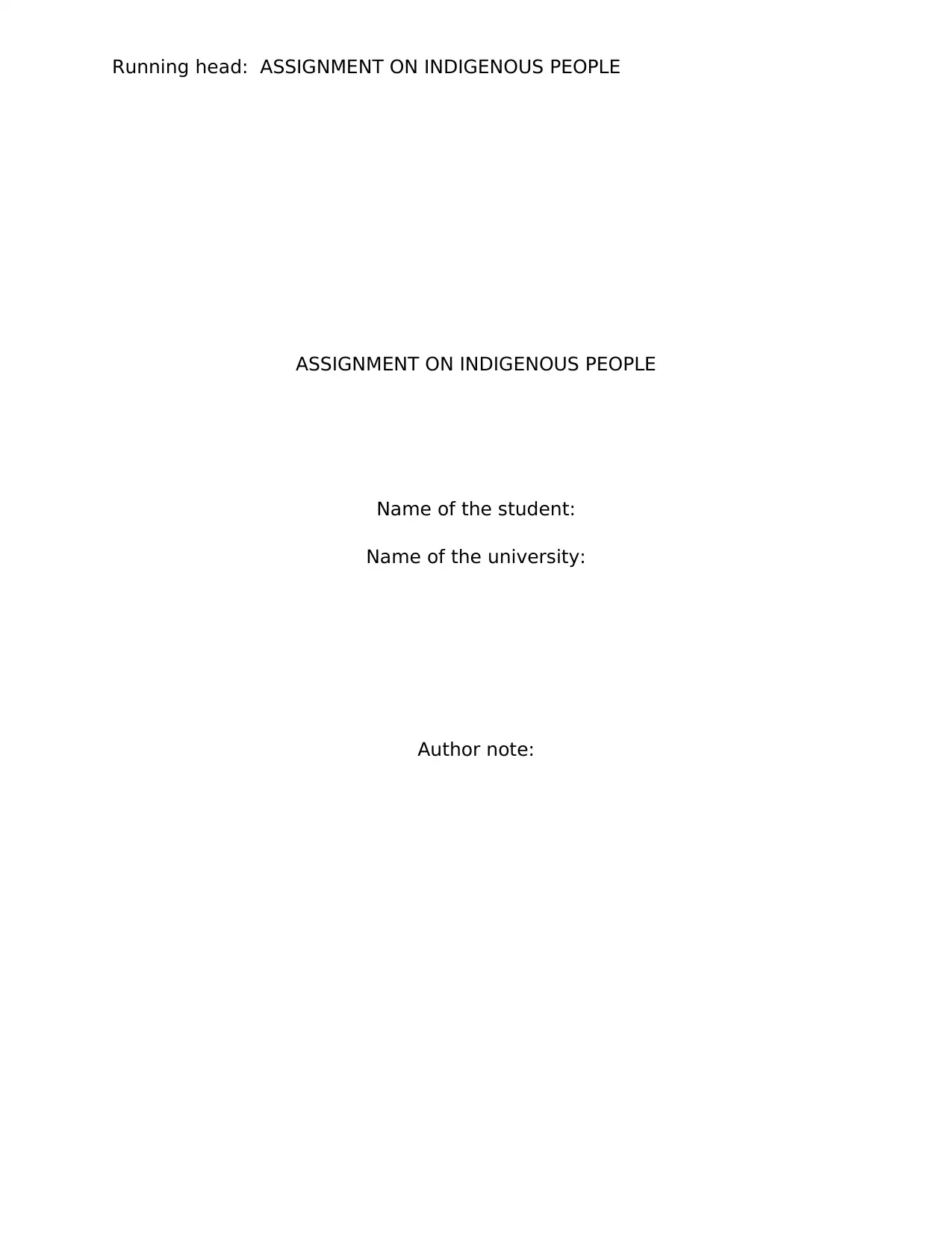
Running head: ASSIGNMENT ON INDIGENOUS PEOPLE
ASSIGNMENT ON INDIGENOUS PEOPLE
Name of the student:
Name of the university:
Author note:
ASSIGNMENT ON INDIGENOUS PEOPLE
Name of the student:
Name of the university:
Author note:
Paraphrase This Document
Need a fresh take? Get an instant paraphrase of this document with our AI Paraphraser
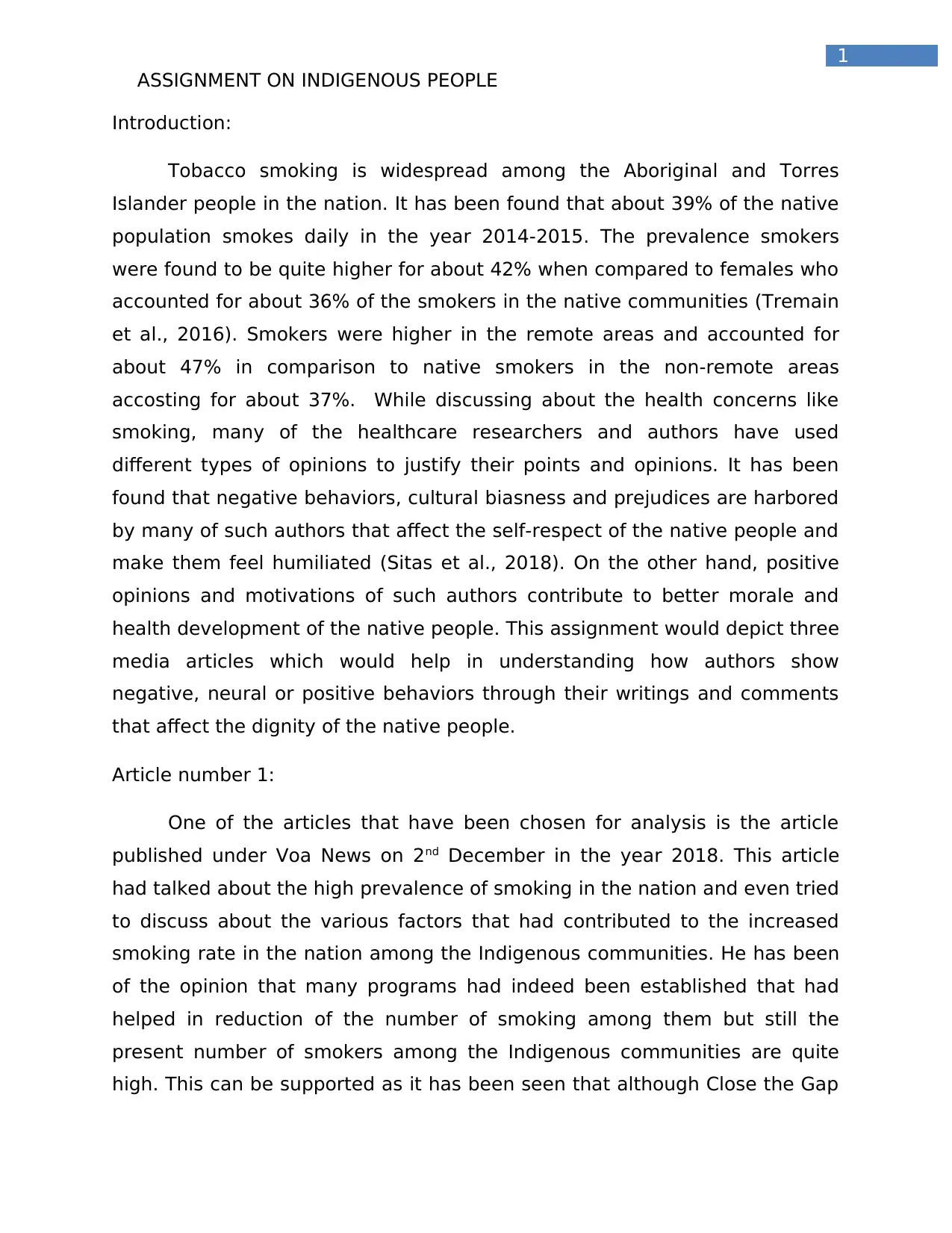
1
ASSIGNMENT ON INDIGENOUS PEOPLE
Introduction:
Tobacco smoking is widespread among the Aboriginal and Torres
Islander people in the nation. It has been found that about 39% of the native
population smokes daily in the year 2014-2015. The prevalence smokers
were found to be quite higher for about 42% when compared to females who
accounted for about 36% of the smokers in the native communities (Tremain
et al., 2016). Smokers were higher in the remote areas and accounted for
about 47% in comparison to native smokers in the non-remote areas
accosting for about 37%. While discussing about the health concerns like
smoking, many of the healthcare researchers and authors have used
different types of opinions to justify their points and opinions. It has been
found that negative behaviors, cultural biasness and prejudices are harbored
by many of such authors that affect the self-respect of the native people and
make them feel humiliated (Sitas et al., 2018). On the other hand, positive
opinions and motivations of such authors contribute to better morale and
health development of the native people. This assignment would depict three
media articles which would help in understanding how authors show
negative, neural or positive behaviors through their writings and comments
that affect the dignity of the native people.
Article number 1:
One of the articles that have been chosen for analysis is the article
published under Voa News on 2nd December in the year 2018. This article
had talked about the high prevalence of smoking in the nation and even tried
to discuss about the various factors that had contributed to the increased
smoking rate in the nation among the Indigenous communities. He has been
of the opinion that many programs had indeed been established that had
helped in reduction of the number of smoking among them but still the
present number of smokers among the Indigenous communities are quite
high. This can be supported as it has been seen that although Close the Gap
ASSIGNMENT ON INDIGENOUS PEOPLE
Introduction:
Tobacco smoking is widespread among the Aboriginal and Torres
Islander people in the nation. It has been found that about 39% of the native
population smokes daily in the year 2014-2015. The prevalence smokers
were found to be quite higher for about 42% when compared to females who
accounted for about 36% of the smokers in the native communities (Tremain
et al., 2016). Smokers were higher in the remote areas and accounted for
about 47% in comparison to native smokers in the non-remote areas
accosting for about 37%. While discussing about the health concerns like
smoking, many of the healthcare researchers and authors have used
different types of opinions to justify their points and opinions. It has been
found that negative behaviors, cultural biasness and prejudices are harbored
by many of such authors that affect the self-respect of the native people and
make them feel humiliated (Sitas et al., 2018). On the other hand, positive
opinions and motivations of such authors contribute to better morale and
health development of the native people. This assignment would depict three
media articles which would help in understanding how authors show
negative, neural or positive behaviors through their writings and comments
that affect the dignity of the native people.
Article number 1:
One of the articles that have been chosen for analysis is the article
published under Voa News on 2nd December in the year 2018. This article
had talked about the high prevalence of smoking in the nation and even tried
to discuss about the various factors that had contributed to the increased
smoking rate in the nation among the Indigenous communities. He has been
of the opinion that many programs had indeed been established that had
helped in reduction of the number of smoking among them but still the
present number of smokers among the Indigenous communities are quite
high. This can be supported as it has been seen that although Close the Gap
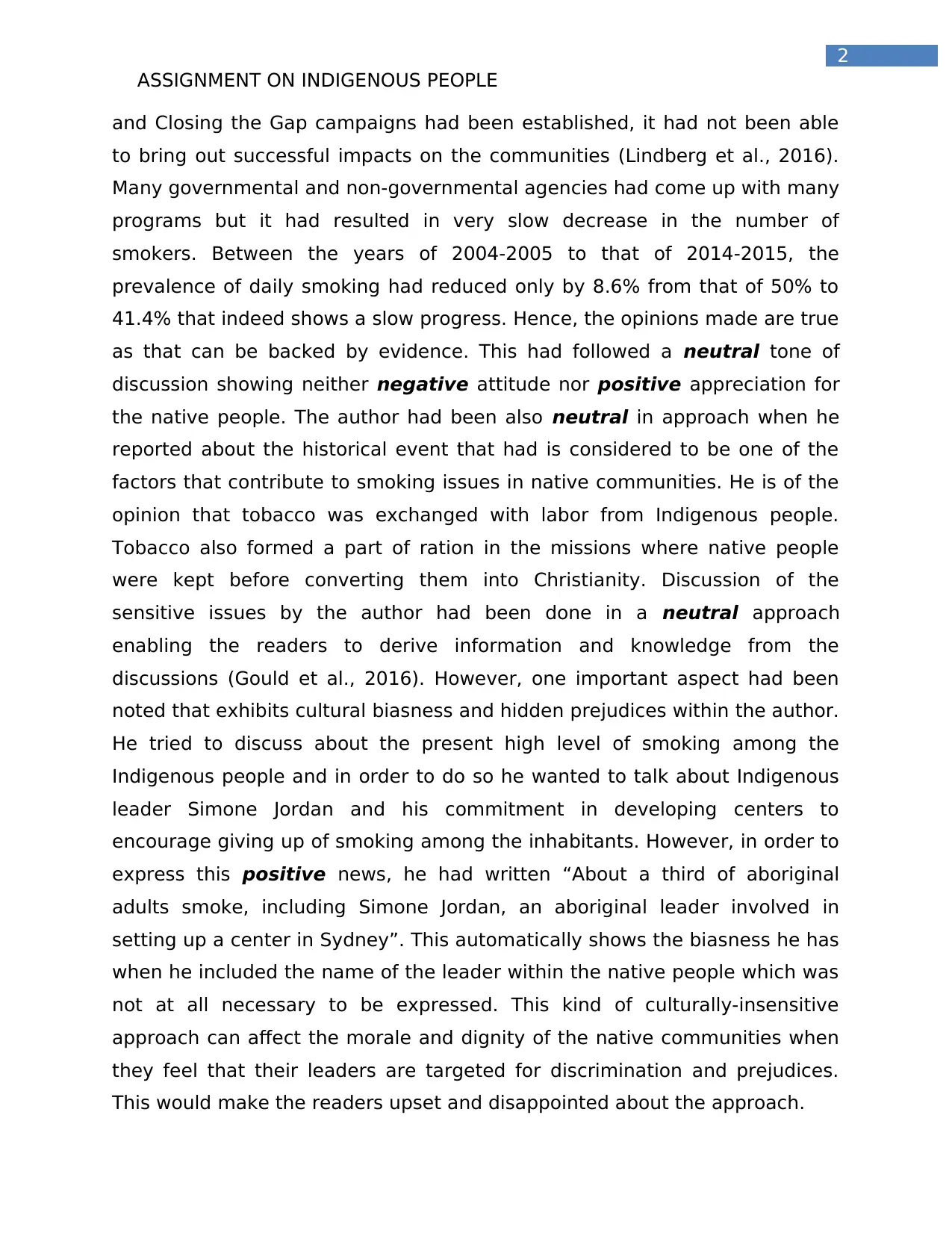
2
ASSIGNMENT ON INDIGENOUS PEOPLE
and Closing the Gap campaigns had been established, it had not been able
to bring out successful impacts on the communities (Lindberg et al., 2016).
Many governmental and non-governmental agencies had come up with many
programs but it had resulted in very slow decrease in the number of
smokers. Between the years of 2004-2005 to that of 2014-2015, the
prevalence of daily smoking had reduced only by 8.6% from that of 50% to
41.4% that indeed shows a slow progress. Hence, the opinions made are true
as that can be backed by evidence. This had followed a neutral tone of
discussion showing neither negative attitude nor positive appreciation for
the native people. The author had been also neutral in approach when he
reported about the historical event that had is considered to be one of the
factors that contribute to smoking issues in native communities. He is of the
opinion that tobacco was exchanged with labor from Indigenous people.
Tobacco also formed a part of ration in the missions where native people
were kept before converting them into Christianity. Discussion of the
sensitive issues by the author had been done in a neutral approach
enabling the readers to derive information and knowledge from the
discussions (Gould et al., 2016). However, one important aspect had been
noted that exhibits cultural biasness and hidden prejudices within the author.
He tried to discuss about the present high level of smoking among the
Indigenous people and in order to do so he wanted to talk about Indigenous
leader Simone Jordan and his commitment in developing centers to
encourage giving up of smoking among the inhabitants. However, in order to
express this positive news, he had written “About a third of aboriginal
adults smoke, including Simone Jordan, an aboriginal leader involved in
setting up a center in Sydney”. This automatically shows the biasness he has
when he included the name of the leader within the native people which was
not at all necessary to be expressed. This kind of culturally-insensitive
approach can affect the morale and dignity of the native communities when
they feel that their leaders are targeted for discrimination and prejudices.
This would make the readers upset and disappointed about the approach.
ASSIGNMENT ON INDIGENOUS PEOPLE
and Closing the Gap campaigns had been established, it had not been able
to bring out successful impacts on the communities (Lindberg et al., 2016).
Many governmental and non-governmental agencies had come up with many
programs but it had resulted in very slow decrease in the number of
smokers. Between the years of 2004-2005 to that of 2014-2015, the
prevalence of daily smoking had reduced only by 8.6% from that of 50% to
41.4% that indeed shows a slow progress. Hence, the opinions made are true
as that can be backed by evidence. This had followed a neutral tone of
discussion showing neither negative attitude nor positive appreciation for
the native people. The author had been also neutral in approach when he
reported about the historical event that had is considered to be one of the
factors that contribute to smoking issues in native communities. He is of the
opinion that tobacco was exchanged with labor from Indigenous people.
Tobacco also formed a part of ration in the missions where native people
were kept before converting them into Christianity. Discussion of the
sensitive issues by the author had been done in a neutral approach
enabling the readers to derive information and knowledge from the
discussions (Gould et al., 2016). However, one important aspect had been
noted that exhibits cultural biasness and hidden prejudices within the author.
He tried to discuss about the present high level of smoking among the
Indigenous people and in order to do so he wanted to talk about Indigenous
leader Simone Jordan and his commitment in developing centers to
encourage giving up of smoking among the inhabitants. However, in order to
express this positive news, he had written “About a third of aboriginal
adults smoke, including Simone Jordan, an aboriginal leader involved in
setting up a center in Sydney”. This automatically shows the biasness he has
when he included the name of the leader within the native people which was
not at all necessary to be expressed. This kind of culturally-insensitive
approach can affect the morale and dignity of the native communities when
they feel that their leaders are targeted for discrimination and prejudices.
This would make the readers upset and disappointed about the approach.
⊘ This is a preview!⊘
Do you want full access?
Subscribe today to unlock all pages.

Trusted by 1+ million students worldwide
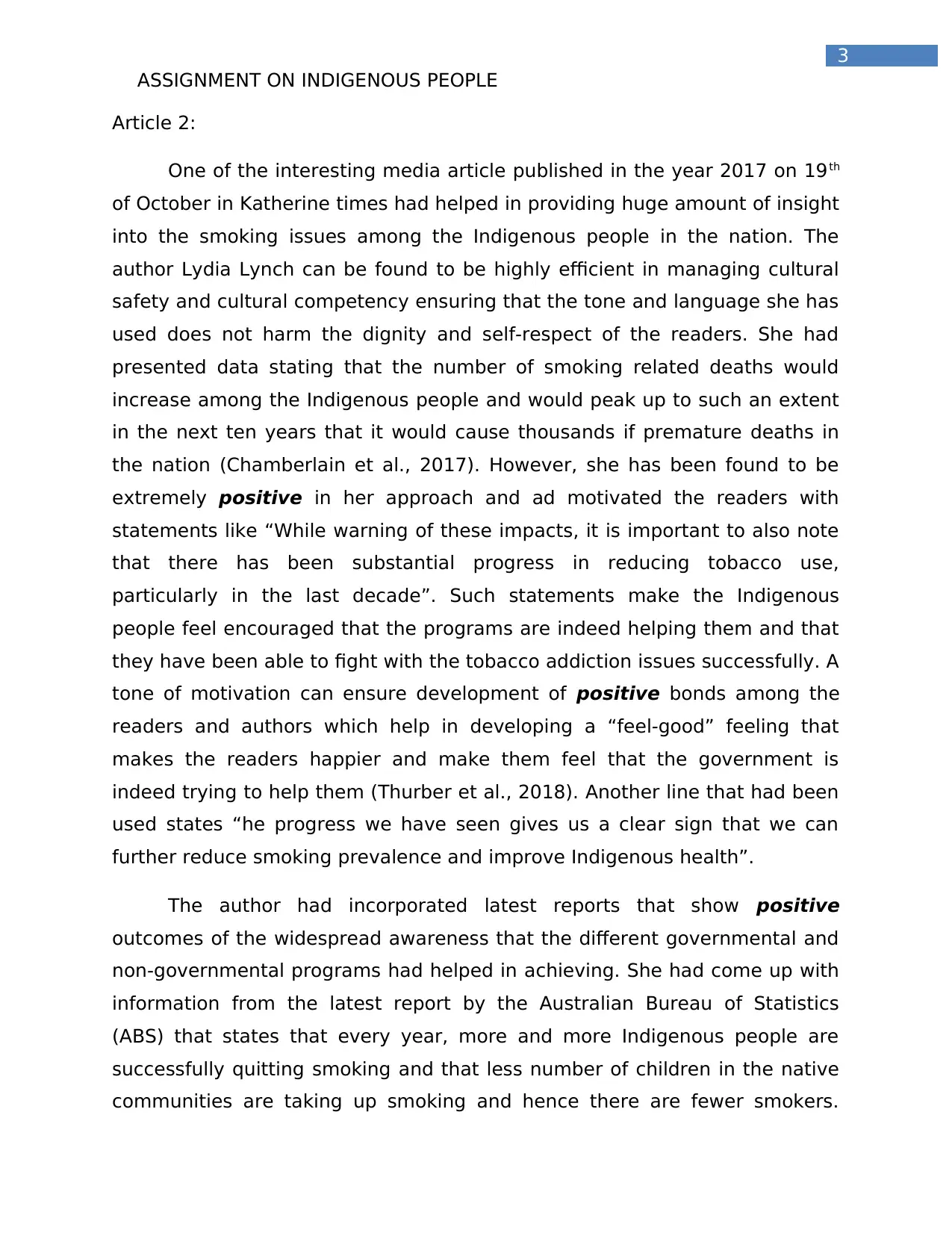
3
ASSIGNMENT ON INDIGENOUS PEOPLE
Article 2:
One of the interesting media article published in the year 2017 on 19th
of October in Katherine times had helped in providing huge amount of insight
into the smoking issues among the Indigenous people in the nation. The
author Lydia Lynch can be found to be highly efficient in managing cultural
safety and cultural competency ensuring that the tone and language she has
used does not harm the dignity and self-respect of the readers. She had
presented data stating that the number of smoking related deaths would
increase among the Indigenous people and would peak up to such an extent
in the next ten years that it would cause thousands if premature deaths in
the nation (Chamberlain et al., 2017). However, she has been found to be
extremely positive in her approach and ad motivated the readers with
statements like “While warning of these impacts, it is important to also note
that there has been substantial progress in reducing tobacco use,
particularly in the last decade”. Such statements make the Indigenous
people feel encouraged that the programs are indeed helping them and that
they have been able to fight with the tobacco addiction issues successfully. A
tone of motivation can ensure development of positive bonds among the
readers and authors which help in developing a “feel-good” feeling that
makes the readers happier and make them feel that the government is
indeed trying to help them (Thurber et al., 2018). Another line that had been
used states “he progress we have seen gives us a clear sign that we can
further reduce smoking prevalence and improve Indigenous health”.
The author had incorporated latest reports that show positive
outcomes of the widespread awareness that the different governmental and
non-governmental programs had helped in achieving. She had come up with
information from the latest report by the Australian Bureau of Statistics
(ABS) that states that every year, more and more Indigenous people are
successfully quitting smoking and that less number of children in the native
communities are taking up smoking and hence there are fewer smokers.
ASSIGNMENT ON INDIGENOUS PEOPLE
Article 2:
One of the interesting media article published in the year 2017 on 19th
of October in Katherine times had helped in providing huge amount of insight
into the smoking issues among the Indigenous people in the nation. The
author Lydia Lynch can be found to be highly efficient in managing cultural
safety and cultural competency ensuring that the tone and language she has
used does not harm the dignity and self-respect of the readers. She had
presented data stating that the number of smoking related deaths would
increase among the Indigenous people and would peak up to such an extent
in the next ten years that it would cause thousands if premature deaths in
the nation (Chamberlain et al., 2017). However, she has been found to be
extremely positive in her approach and ad motivated the readers with
statements like “While warning of these impacts, it is important to also note
that there has been substantial progress in reducing tobacco use,
particularly in the last decade”. Such statements make the Indigenous
people feel encouraged that the programs are indeed helping them and that
they have been able to fight with the tobacco addiction issues successfully. A
tone of motivation can ensure development of positive bonds among the
readers and authors which help in developing a “feel-good” feeling that
makes the readers happier and make them feel that the government is
indeed trying to help them (Thurber et al., 2018). Another line that had been
used states “he progress we have seen gives us a clear sign that we can
further reduce smoking prevalence and improve Indigenous health”.
The author had incorporated latest reports that show positive
outcomes of the widespread awareness that the different governmental and
non-governmental programs had helped in achieving. She had come up with
information from the latest report by the Australian Bureau of Statistics
(ABS) that states that every year, more and more Indigenous people are
successfully quitting smoking and that less number of children in the native
communities are taking up smoking and hence there are fewer smokers.
Paraphrase This Document
Need a fresh take? Get an instant paraphrase of this document with our AI Paraphraser
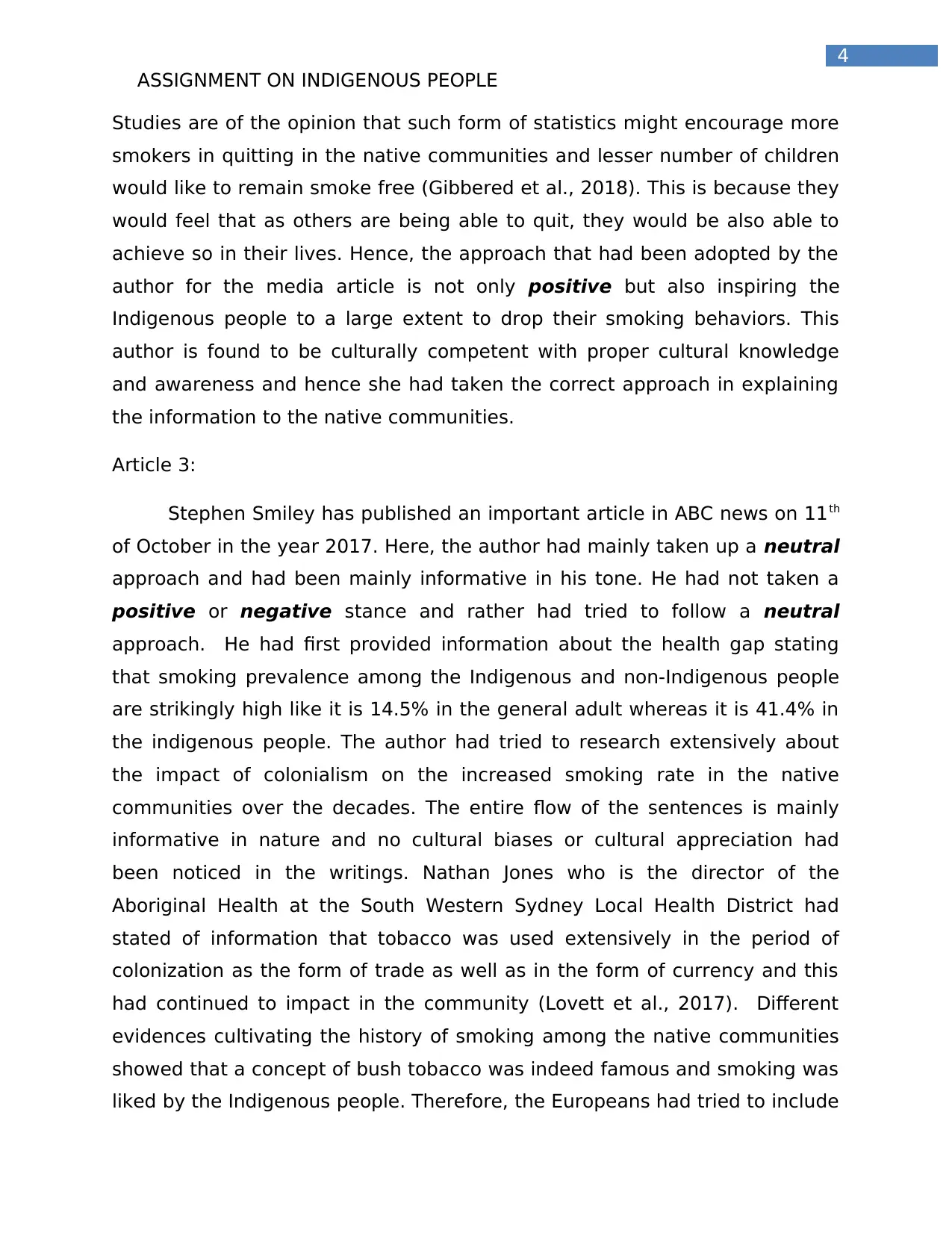
4
ASSIGNMENT ON INDIGENOUS PEOPLE
Studies are of the opinion that such form of statistics might encourage more
smokers in quitting in the native communities and lesser number of children
would like to remain smoke free (Gibbered et al., 2018). This is because they
would feel that as others are being able to quit, they would be also able to
achieve so in their lives. Hence, the approach that had been adopted by the
author for the media article is not only positive but also inspiring the
Indigenous people to a large extent to drop their smoking behaviors. This
author is found to be culturally competent with proper cultural knowledge
and awareness and hence she had taken the correct approach in explaining
the information to the native communities.
Article 3:
Stephen Smiley has published an important article in ABC news on 11th
of October in the year 2017. Here, the author had mainly taken up a neutral
approach and had been mainly informative in his tone. He had not taken a
positive or negative stance and rather had tried to follow a neutral
approach. He had first provided information about the health gap stating
that smoking prevalence among the Indigenous and non-Indigenous people
are strikingly high like it is 14.5% in the general adult whereas it is 41.4% in
the indigenous people. The author had tried to research extensively about
the impact of colonialism on the increased smoking rate in the native
communities over the decades. The entire flow of the sentences is mainly
informative in nature and no cultural biases or cultural appreciation had
been noticed in the writings. Nathan Jones who is the director of the
Aboriginal Health at the South Western Sydney Local Health District had
stated of information that tobacco was used extensively in the period of
colonization as the form of trade as well as in the form of currency and this
had continued to impact in the community (Lovett et al., 2017). Different
evidences cultivating the history of smoking among the native communities
showed that a concept of bush tobacco was indeed famous and smoking was
liked by the Indigenous people. Therefore, the Europeans had tried to include
ASSIGNMENT ON INDIGENOUS PEOPLE
Studies are of the opinion that such form of statistics might encourage more
smokers in quitting in the native communities and lesser number of children
would like to remain smoke free (Gibbered et al., 2018). This is because they
would feel that as others are being able to quit, they would be also able to
achieve so in their lives. Hence, the approach that had been adopted by the
author for the media article is not only positive but also inspiring the
Indigenous people to a large extent to drop their smoking behaviors. This
author is found to be culturally competent with proper cultural knowledge
and awareness and hence she had taken the correct approach in explaining
the information to the native communities.
Article 3:
Stephen Smiley has published an important article in ABC news on 11th
of October in the year 2017. Here, the author had mainly taken up a neutral
approach and had been mainly informative in his tone. He had not taken a
positive or negative stance and rather had tried to follow a neutral
approach. He had first provided information about the health gap stating
that smoking prevalence among the Indigenous and non-Indigenous people
are strikingly high like it is 14.5% in the general adult whereas it is 41.4% in
the indigenous people. The author had tried to research extensively about
the impact of colonialism on the increased smoking rate in the native
communities over the decades. The entire flow of the sentences is mainly
informative in nature and no cultural biases or cultural appreciation had
been noticed in the writings. Nathan Jones who is the director of the
Aboriginal Health at the South Western Sydney Local Health District had
stated of information that tobacco was used extensively in the period of
colonization as the form of trade as well as in the form of currency and this
had continued to impact in the community (Lovett et al., 2017). Different
evidences cultivating the history of smoking among the native communities
showed that a concept of bush tobacco was indeed famous and smoking was
liked by the Indigenous people. Therefore, the Europeans had tried to include
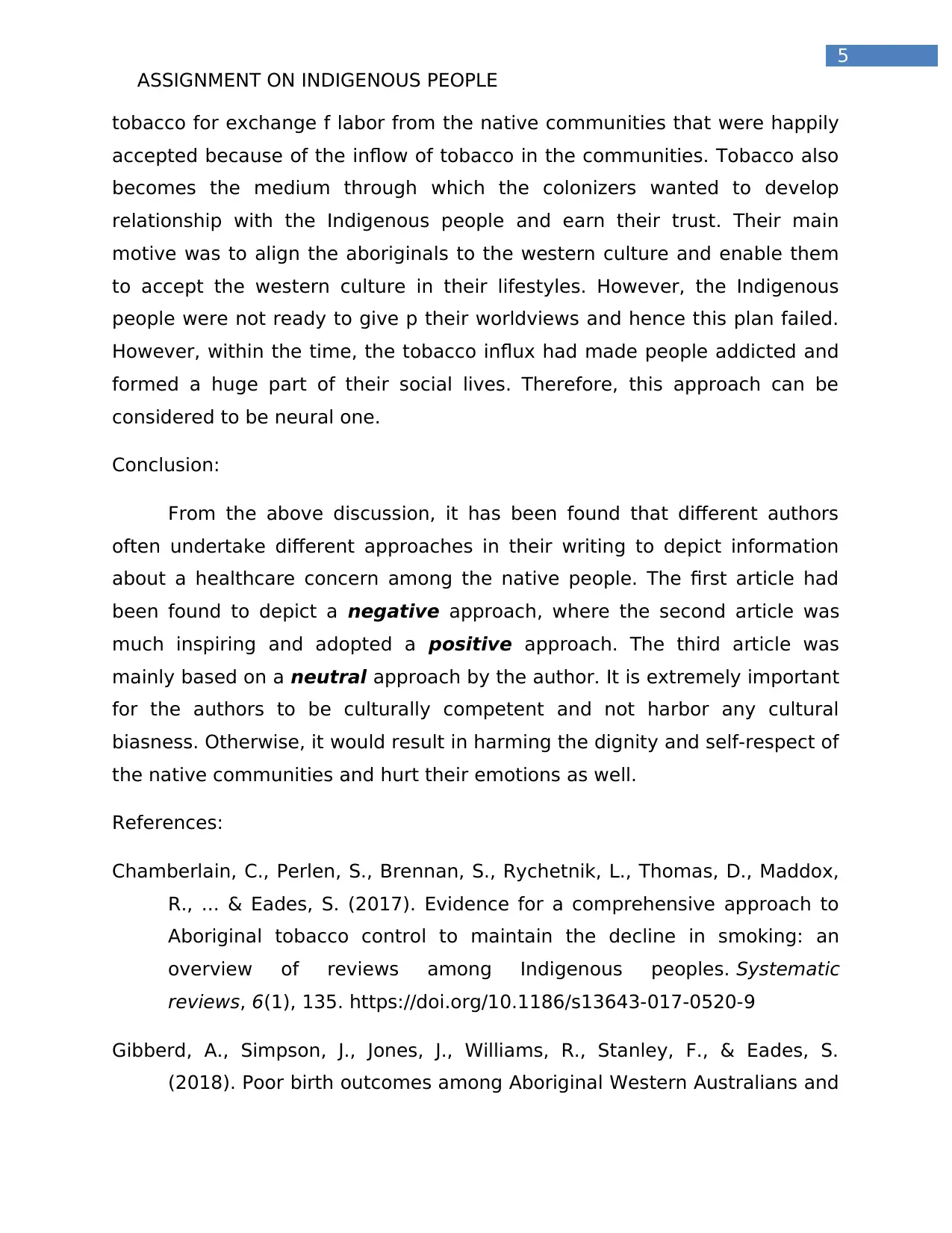
5
ASSIGNMENT ON INDIGENOUS PEOPLE
tobacco for exchange f labor from the native communities that were happily
accepted because of the inflow of tobacco in the communities. Tobacco also
becomes the medium through which the colonizers wanted to develop
relationship with the Indigenous people and earn their trust. Their main
motive was to align the aboriginals to the western culture and enable them
to accept the western culture in their lifestyles. However, the Indigenous
people were not ready to give p their worldviews and hence this plan failed.
However, within the time, the tobacco influx had made people addicted and
formed a huge part of their social lives. Therefore, this approach can be
considered to be neural one.
Conclusion:
From the above discussion, it has been found that different authors
often undertake different approaches in their writing to depict information
about a healthcare concern among the native people. The first article had
been found to depict a negative approach, where the second article was
much inspiring and adopted a positive approach. The third article was
mainly based on a neutral approach by the author. It is extremely important
for the authors to be culturally competent and not harbor any cultural
biasness. Otherwise, it would result in harming the dignity and self-respect of
the native communities and hurt their emotions as well.
References:
Chamberlain, C., Perlen, S., Brennan, S., Rychetnik, L., Thomas, D., Maddox,
R., ... & Eades, S. (2017). Evidence for a comprehensive approach to
Aboriginal tobacco control to maintain the decline in smoking: an
overview of reviews among Indigenous peoples. Systematic
reviews, 6(1), 135. https://doi.org/10.1186/s13643-017-0520-9
Gibberd, A., Simpson, J., Jones, J., Williams, R., Stanley, F., & Eades, S.
(2018). Poor birth outcomes among Aboriginal Western Australians and
ASSIGNMENT ON INDIGENOUS PEOPLE
tobacco for exchange f labor from the native communities that were happily
accepted because of the inflow of tobacco in the communities. Tobacco also
becomes the medium through which the colonizers wanted to develop
relationship with the Indigenous people and earn their trust. Their main
motive was to align the aboriginals to the western culture and enable them
to accept the western culture in their lifestyles. However, the Indigenous
people were not ready to give p their worldviews and hence this plan failed.
However, within the time, the tobacco influx had made people addicted and
formed a huge part of their social lives. Therefore, this approach can be
considered to be neural one.
Conclusion:
From the above discussion, it has been found that different authors
often undertake different approaches in their writing to depict information
about a healthcare concern among the native people. The first article had
been found to depict a negative approach, where the second article was
much inspiring and adopted a positive approach. The third article was
mainly based on a neutral approach by the author. It is extremely important
for the authors to be culturally competent and not harbor any cultural
biasness. Otherwise, it would result in harming the dignity and self-respect of
the native communities and hurt their emotions as well.
References:
Chamberlain, C., Perlen, S., Brennan, S., Rychetnik, L., Thomas, D., Maddox,
R., ... & Eades, S. (2017). Evidence for a comprehensive approach to
Aboriginal tobacco control to maintain the decline in smoking: an
overview of reviews among Indigenous peoples. Systematic
reviews, 6(1), 135. https://doi.org/10.1186/s13643-017-0520-9
Gibberd, A., Simpson, J., Jones, J., Williams, R., Stanley, F., & Eades, S.
(2018). Poor birth outcomes among Aboriginal Western Australians and
⊘ This is a preview!⊘
Do you want full access?
Subscribe today to unlock all pages.

Trusted by 1+ million students worldwide
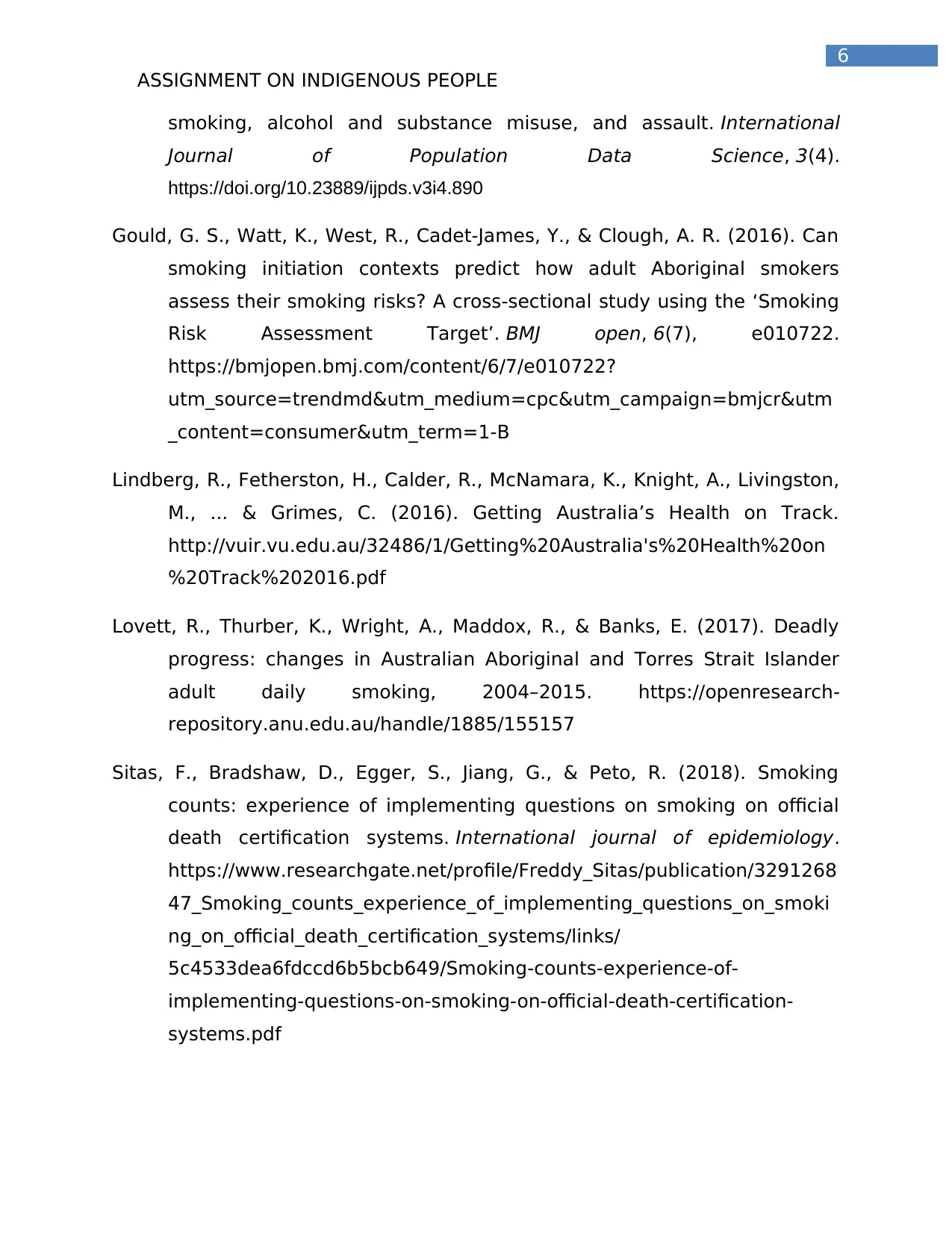
6
ASSIGNMENT ON INDIGENOUS PEOPLE
smoking, alcohol and substance misuse, and assault. International
Journal of Population Data Science, 3(4).
https://doi.org/10.23889/ijpds.v3i4.890
Gould, G. S., Watt, K., West, R., Cadet-James, Y., & Clough, A. R. (2016). Can
smoking initiation contexts predict how adult Aboriginal smokers
assess their smoking risks? A cross-sectional study using the ‘Smoking
Risk Assessment Target’. BMJ open, 6(7), e010722.
https://bmjopen.bmj.com/content/6/7/e010722?
utm_source=trendmd&utm_medium=cpc&utm_campaign=bmjcr&utm
_content=consumer&utm_term=1-B
Lindberg, R., Fetherston, H., Calder, R., McNamara, K., Knight, A., Livingston,
M., ... & Grimes, C. (2016). Getting Australia’s Health on Track.
http://vuir.vu.edu.au/32486/1/Getting%20Australia's%20Health%20on
%20Track%202016.pdf
Lovett, R., Thurber, K., Wright, A., Maddox, R., & Banks, E. (2017). Deadly
progress: changes in Australian Aboriginal and Torres Strait Islander
adult daily smoking, 2004–2015. https://openresearch-
repository.anu.edu.au/handle/1885/155157
Sitas, F., Bradshaw, D., Egger, S., Jiang, G., & Peto, R. (2018). Smoking
counts: experience of implementing questions on smoking on official
death certification systems. International journal of epidemiology.
https://www.researchgate.net/profile/Freddy_Sitas/publication/3291268
47_Smoking_counts_experience_of_implementing_questions_on_smoki
ng_on_official_death_certification_systems/links/
5c4533dea6fdccd6b5bcb649/Smoking-counts-experience-of-
implementing-questions-on-smoking-on-official-death-certification-
systems.pdf
ASSIGNMENT ON INDIGENOUS PEOPLE
smoking, alcohol and substance misuse, and assault. International
Journal of Population Data Science, 3(4).
https://doi.org/10.23889/ijpds.v3i4.890
Gould, G. S., Watt, K., West, R., Cadet-James, Y., & Clough, A. R. (2016). Can
smoking initiation contexts predict how adult Aboriginal smokers
assess their smoking risks? A cross-sectional study using the ‘Smoking
Risk Assessment Target’. BMJ open, 6(7), e010722.
https://bmjopen.bmj.com/content/6/7/e010722?
utm_source=trendmd&utm_medium=cpc&utm_campaign=bmjcr&utm
_content=consumer&utm_term=1-B
Lindberg, R., Fetherston, H., Calder, R., McNamara, K., Knight, A., Livingston,
M., ... & Grimes, C. (2016). Getting Australia’s Health on Track.
http://vuir.vu.edu.au/32486/1/Getting%20Australia's%20Health%20on
%20Track%202016.pdf
Lovett, R., Thurber, K., Wright, A., Maddox, R., & Banks, E. (2017). Deadly
progress: changes in Australian Aboriginal and Torres Strait Islander
adult daily smoking, 2004–2015. https://openresearch-
repository.anu.edu.au/handle/1885/155157
Sitas, F., Bradshaw, D., Egger, S., Jiang, G., & Peto, R. (2018). Smoking
counts: experience of implementing questions on smoking on official
death certification systems. International journal of epidemiology.
https://www.researchgate.net/profile/Freddy_Sitas/publication/3291268
47_Smoking_counts_experience_of_implementing_questions_on_smoki
ng_on_official_death_certification_systems/links/
5c4533dea6fdccd6b5bcb649/Smoking-counts-experience-of-
implementing-questions-on-smoking-on-official-death-certification-
systems.pdf
Paraphrase This Document
Need a fresh take? Get an instant paraphrase of this document with our AI Paraphraser
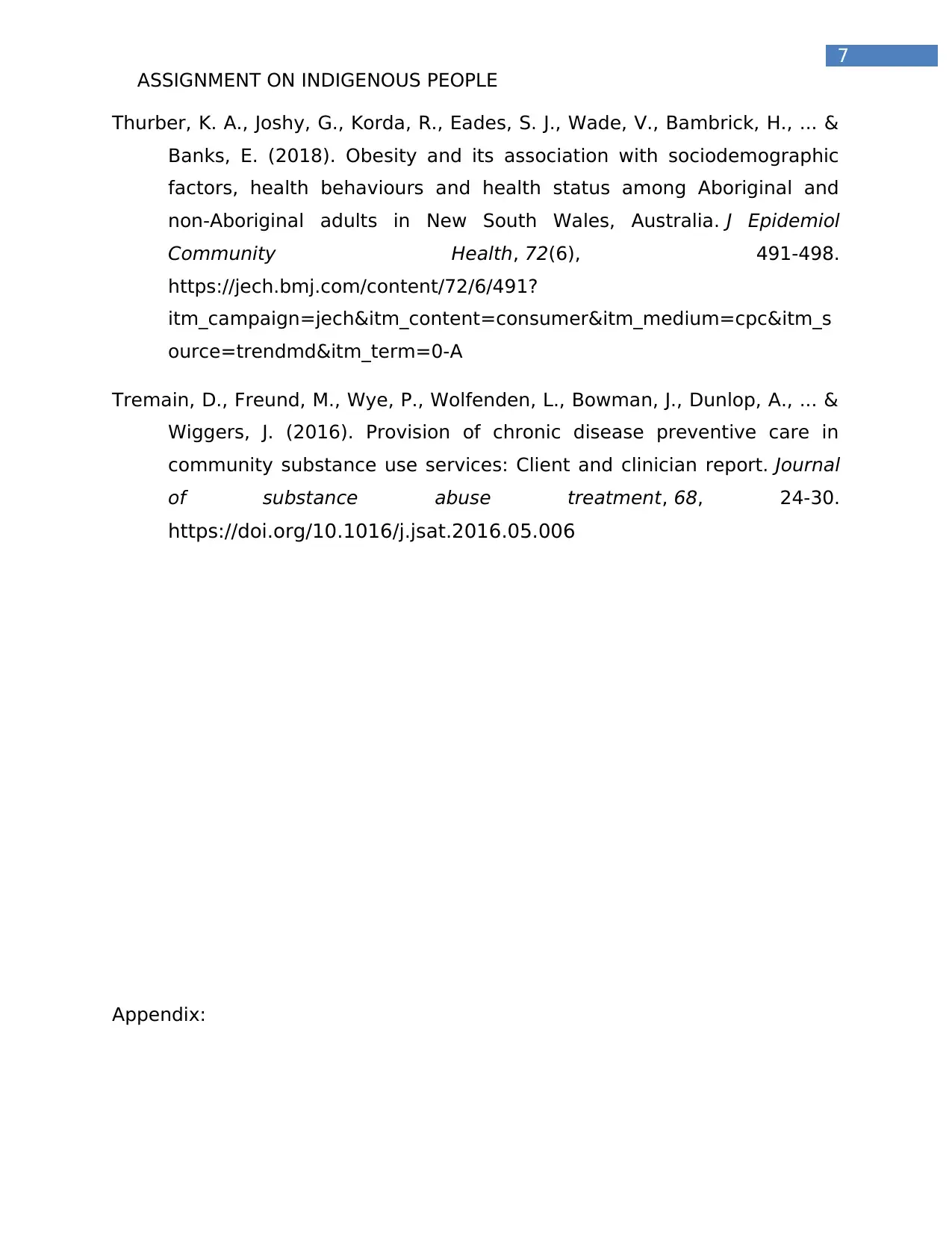
7
ASSIGNMENT ON INDIGENOUS PEOPLE
Thurber, K. A., Joshy, G., Korda, R., Eades, S. J., Wade, V., Bambrick, H., ... &
Banks, E. (2018). Obesity and its association with sociodemographic
factors, health behaviours and health status among Aboriginal and
non-Aboriginal adults in New South Wales, Australia. J Epidemiol
Community Health, 72(6), 491-498.
https://jech.bmj.com/content/72/6/491?
itm_campaign=jech&itm_content=consumer&itm_medium=cpc&itm_s
ource=trendmd&itm_term=0-A
Tremain, D., Freund, M., Wye, P., Wolfenden, L., Bowman, J., Dunlop, A., ... &
Wiggers, J. (2016). Provision of chronic disease preventive care in
community substance use services: Client and clinician report. Journal
of substance abuse treatment, 68, 24-30.
https://doi.org/10.1016/j.jsat.2016.05.006
Appendix:
ASSIGNMENT ON INDIGENOUS PEOPLE
Thurber, K. A., Joshy, G., Korda, R., Eades, S. J., Wade, V., Bambrick, H., ... &
Banks, E. (2018). Obesity and its association with sociodemographic
factors, health behaviours and health status among Aboriginal and
non-Aboriginal adults in New South Wales, Australia. J Epidemiol
Community Health, 72(6), 491-498.
https://jech.bmj.com/content/72/6/491?
itm_campaign=jech&itm_content=consumer&itm_medium=cpc&itm_s
ource=trendmd&itm_term=0-A
Tremain, D., Freund, M., Wye, P., Wolfenden, L., Bowman, J., Dunlop, A., ... &
Wiggers, J. (2016). Provision of chronic disease preventive care in
community substance use services: Client and clinician report. Journal
of substance abuse treatment, 68, 24-30.
https://doi.org/10.1016/j.jsat.2016.05.006
Appendix:
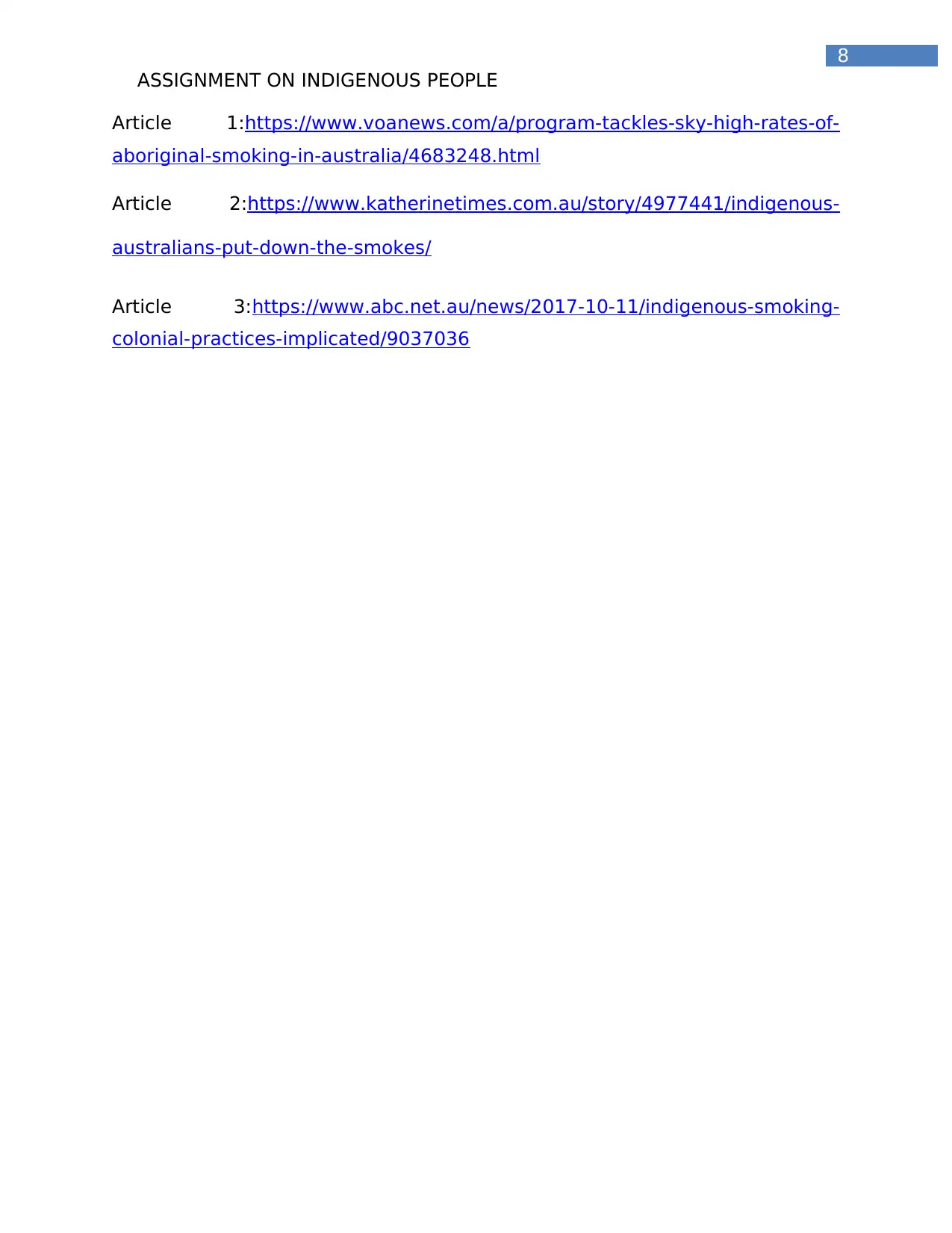
8
ASSIGNMENT ON INDIGENOUS PEOPLE
Article 1:https://www.voanews.com/a/program-tackles-sky-high-rates-of-
aboriginal-smoking-in-australia/4683248.html
Article 2:https://www.katherinetimes.com.au/story/4977441/indigenous-
australians-put-down-the-smokes/
Article 3:https://www.abc.net.au/news/2017-10-11/indigenous-smoking-
colonial-practices-implicated/9037036
ASSIGNMENT ON INDIGENOUS PEOPLE
Article 1:https://www.voanews.com/a/program-tackles-sky-high-rates-of-
aboriginal-smoking-in-australia/4683248.html
Article 2:https://www.katherinetimes.com.au/story/4977441/indigenous-
australians-put-down-the-smokes/
Article 3:https://www.abc.net.au/news/2017-10-11/indigenous-smoking-
colonial-practices-implicated/9037036
⊘ This is a preview!⊘
Do you want full access?
Subscribe today to unlock all pages.

Trusted by 1+ million students worldwide
1 out of 9
Related Documents
Your All-in-One AI-Powered Toolkit for Academic Success.
+13062052269
info@desklib.com
Available 24*7 on WhatsApp / Email
![[object Object]](/_next/static/media/star-bottom.7253800d.svg)
Unlock your academic potential
Copyright © 2020–2025 A2Z Services. All Rights Reserved. Developed and managed by ZUCOL.





